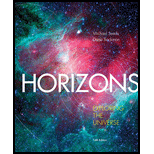
Horizons: Exploring the Universe (MindTap Course List)
14th Edition
ISBN: 9781305960961
Author: Michael A. Seeds, Dana Backman
Publisher: Cengage Learning
expand_more
expand_more
format_list_bulleted
Textbook Question
Chapter 15, Problem 3DQ
If the solar nebula hypothesis is correct, do you think there e more planets in the Universe than stars? Why or why not?
Expert Solution & Answer
Trending nowThis is a popular solution!

Students have asked these similar questions
If the solar nebula hypothesis is correct, do you think there are more planets in the Universe than stars? Why or why not?
how does the solar nebula theory help you understand the location of the asteriod belt
Chapter 15 Solutions
Horizons: Exploring the Universe (MindTap Course List)
Ch. 15 - What produced the helium now present in the Sun’s...Ch. 15 - What produced the iron and heavier elements like...Ch. 15 - What evidence can you cite that disks of gas and...Ch. 15 - According to the solar nebula theory, why is the...Ch. 15 - Why does the solar nebula theory predict that...Ch. 15 - Prob. 6RQCh. 15 - If you visited another planetary system, would you...Ch. 15 - Why is almost every solid surface in our Solar...Ch. 15 - What is the difference between condensation and...Ch. 15 - Why don’t Terrestrial planets have rings like the...
Ch. 15 - How does the solar nebula theory help you...Ch. 15 - How does the solar nebula theory explain the...Ch. 15 - What does the term differentiated mean when...Ch. 15 - What processes cleared the nebula away and ended...Ch. 15 - Why would astronomically short lifetime of gas and...Ch. 15 - Prob. 16RQCh. 15 - What evidence can you cite that planets orbit...Ch. 15 - Why is the existence of “hot Jupiters” puzzling?...Ch. 15 - How Do We know? The evidence is overwhelming in...Ch. 15 - How Do We know? How can scientists know anything...Ch. 15 - If you could visit another planetary system while...Ch. 15 - Prob. 2DQCh. 15 - If the solar nebula hypothesis is correct, do you...Ch. 15 - If you observed the Solar System from the nearest...Ch. 15 - Prob. 2PCh. 15 - Prob. 3PCh. 15 - Prob. 4PCh. 15 - Prob. 5PCh. 15 - Prob. 6PCh. 15 - Suppose that Earth grew to its present size in 1...Ch. 15 - Prob. 8PCh. 15 - Prob. 9PCh. 15 - Prob. 1LTLCh. 15 - Why do astronomers conclude that the surface of...Ch. 15 - Prob. 3LTL
Knowledge Booster
Learn more about
Need a deep-dive on the concept behind this application? Look no further. Learn more about this topic, physics and related others by exploring similar questions and additional content below.Similar questions
- What characteristics do the worlds in our solar system have in common that lead astronomers to believe that they all formed from the same “mother cloud” (solar nebula)?arrow_forwardWhy was the nebular hypothesis never fully accepted by astronomers of the day?arrow_forwardHow do we know when the solar system formed? Usually we say that the solar system is 4.5 billion years old. To what does this age correspond?arrow_forward
- Describe the solar nebula, and outline the sequence of events within the nebula that gave rise to the planetesimals.arrow_forwardHow does the solar nebula theory explain the significant density difference between the Terrestrial and Jovian planets?arrow_forwardHow does the solar nebula theory explain the orbits of the major planets? Dwarf planets? Does it explain the rotations of the planets? Why or why not?arrow_forward
arrow_back_ios
arrow_forward_ios
Recommended textbooks for you
 Horizons: Exploring the Universe (MindTap Course ...PhysicsISBN:9781305960961Author:Michael A. Seeds, Dana BackmanPublisher:Cengage Learning
Horizons: Exploring the Universe (MindTap Course ...PhysicsISBN:9781305960961Author:Michael A. Seeds, Dana BackmanPublisher:Cengage Learning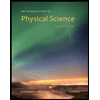 An Introduction to Physical SciencePhysicsISBN:9781305079137Author:James Shipman, Jerry D. Wilson, Charles A. Higgins, Omar TorresPublisher:Cengage Learning
An Introduction to Physical SciencePhysicsISBN:9781305079137Author:James Shipman, Jerry D. Wilson, Charles A. Higgins, Omar TorresPublisher:Cengage Learning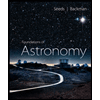 Foundations of Astronomy (MindTap Course List)PhysicsISBN:9781337399920Author:Michael A. Seeds, Dana BackmanPublisher:Cengage Learning
Foundations of Astronomy (MindTap Course List)PhysicsISBN:9781337399920Author:Michael A. Seeds, Dana BackmanPublisher:Cengage Learning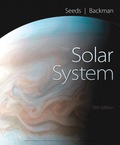
 AstronomyPhysicsISBN:9781938168284Author:Andrew Fraknoi; David Morrison; Sidney C. WolffPublisher:OpenStax
AstronomyPhysicsISBN:9781938168284Author:Andrew Fraknoi; David Morrison; Sidney C. WolffPublisher:OpenStax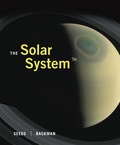

Horizons: Exploring the Universe (MindTap Course ...
Physics
ISBN:9781305960961
Author:Michael A. Seeds, Dana Backman
Publisher:Cengage Learning

An Introduction to Physical Science
Physics
ISBN:9781305079137
Author:James Shipman, Jerry D. Wilson, Charles A. Higgins, Omar Torres
Publisher:Cengage Learning

Foundations of Astronomy (MindTap Course List)
Physics
ISBN:9781337399920
Author:Michael A. Seeds, Dana Backman
Publisher:Cengage Learning


Astronomy
Physics
ISBN:9781938168284
Author:Andrew Fraknoi; David Morrison; Sidney C. Wolff
Publisher:OpenStax

Kepler's Three Laws Explained; Author: PhysicsHigh;https://www.youtube.com/watch?v=kyR6EO_RMKE;License: Standard YouTube License, CC-BY